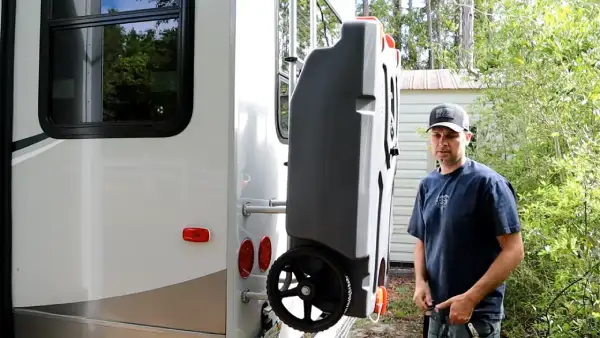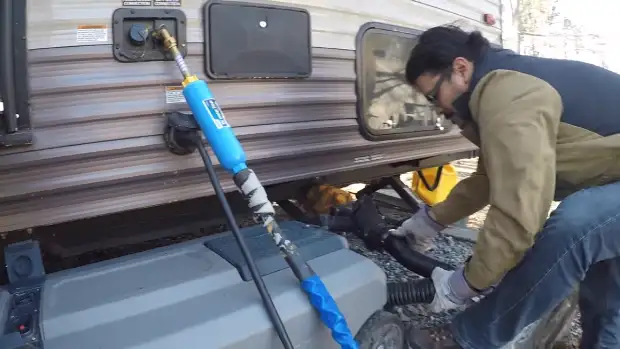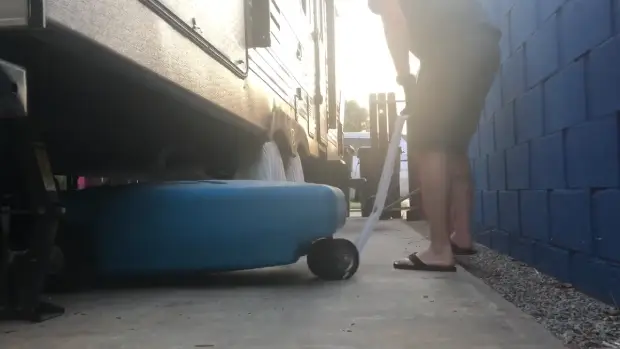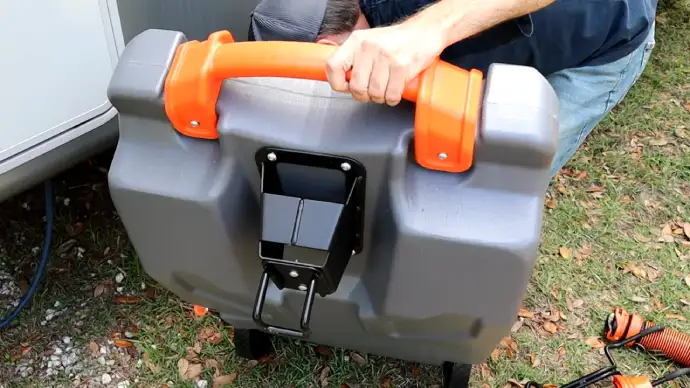Last Updated on September 19, 2023
When hitting the road in an RV, one of the most important things to consider is your waste management system. And a crucial component of that system is your septic tank. But with so many options, how do you know what size septic tank you need for your RV?
The size of your septic tank will depend on several factors, such as the number of people in your RV, the length of your stay, and the frequency of use. The average RV septic water tank size can vary from as little as 15 gallons to 60+ gallons, with larger RVs typically having larger black tanks, such as 100 gallons.
Ready to hit the open road with your RV? Before you set off, ensure you have a septic tank perfectly sized for all your adventures. Here we’ll provide insights so that choosing one is easy and hassle-free.
Factors to Consider when Choosing the Right Size of Septic Tank

Choosing the perfect size septic tank for your RV isn’t complicated if you know what to look out for. It all depends on how many people are part of your party, whether it’s a short or extended stay, and the frequency you’ll use it. Let’s take a look at each of these factors in more detail.
Number of People Using the RV
When figuring out the size of your septic tank for your RV, one of the most important factors to consider is the number of people who will be using it. This is because the more people use the RV, the more wastewater is produced. So, a larger septic tank will be required.
When calculating the number of people who may also use the facilities in your RV, it’s important to consider any guests or visitors who may also use the facilities.
It’s recommended to err on the side of caution and assumes that there will always be at least two people using the RV at any given time.
Once you have determined how many people will be using your RV, you can then move on to calculating your daily wastewater production per person.
This can vary depending on factors such as diet and personal hygiene habits, but as a general rule of thumb, each person produces an average of 20-30 gallons of wastewater per day.
Multiplying this figure by your RV’s total number of occupants will give you an estimate for your total daily wastewater production.
For example, if you have four people in your RV producing an average of 25 gallons each per day, then your total daily wastewater production would be 100 gallons.
By considering all these factors before selecting a septic tank for your RV, you can ensure that you have enough capacity to handle all waste produced without having to empty it too frequently.
Frequency of Use
The frequency of use is an important factor to consider when determining the ideal capacity of a septic tank for your RV. How often you use your RV will affect the amount of wastewater produced and the frequency at which it needs to be emptied.
A smaller septic tank may suffice if you only use your RV occasionally, such as for weekend camping trips. But, a larger septic tank will be necessary if you are a full-time RVer or frequently take extended trips.
It’s also important to note that the frequency of use can impact the maintenance required for your RV’s septic system. If you use your RV infrequently, then it’s crucial to properly maintain and clean your holding tanks before storing them away. This will prevent unpleasant odors and potential damage to the system.
On the other hand, regular cleaning and maintenance should become part of your routine if you frequently use your RV and its septic system. Biodegradable and environmentally friendly stuff is recommended to avoid damaging the system or the environment.
Duration of Stay
When choosing the appropriate size of the septic tank to suit your RV, the duration of stay is an important factor to consider. The longer you plan on staying in your RV, the larger the septic tank you will need.
If you are planning a weekend trip or a short vacation, a smaller septic tank may suffice. But, if you plan on living in your RV full-time or taking extended trips, you will need a larger septic tank to accommodate your wastewater needs.
It’s important to note that even if you have a large septic tank, it still needs to be emptied regularly. The frequency of emptying will depend upon how large your tank is and the amount of wastewater being produced.
Checklist for Maintaining Your RV Septic System

Maintaining your RV septic system is crucial to ensure its proper functioning and longevity. Here are some things to keep in mind:
Regularly Clean Your Holding Tanks
Regularly cleaning your holding tanks is essential to maintaining your RV septic system. Neglecting this task can lead to unpleasant odors and clogs, which can cause damage to your RV’s plumbing system. To avoid these issues, it’s important to establish a regular cleaning schedule for your holding tanks.
The frequency with which you should clean your holding tanks depends on the size of your tank and how many people are using it. As a general rule, it’s recommended that you empty your tanks once they are two-thirds full. This will help prevent any overflow or backup in the system.
Use Biodegradable and Environmentally Safe Chemicals
Using biodegradable and environmentally safe chemicals is important when maintaining your RV septic system. These types of chemicals are designed to break down waste and toilet paper in a way that is safe for the environment.
Chemicals that contain harsh chemicals can not only harm the environment, but they can also damage your septic system. Harsh chemicals can kill the beneficial bacteria that help break down waste in your tank, leading to clogs and backups.
Instead, opt for biodegradable and environmentally safe chemicals that are designed specifically for RV septic systems. These products are formulated to be gentle on your system while effectively breaking down waste.
Properly Dispose Of Waste and Toilet Paper
Properly disposing of waste and toilet paper is crucial for maintaining the health and longevity of your RV septic system. While it may seem like a simple task, there are a few key things to keep in mind.
It’s important to only dispose of human waste and toilet paper in your RV toilet. Anything like feminine hygiene products or baby wipes should be thrown away in a trash can. These items can clog your pipes or damage your septic system.
Ensure you do so when dumping your RV’s holding tanks at an appropriate dump station. Dumping wastewater on the ground or in a body of water is illegal and harmful to the environment. Always follow proper disposal guidelines and regulations.
Use toilet paper that is designated for RV use. Regular household toilet paper can be too thick and difficult to break down in your septic tank. Look for specially designed RV toilet paper that is biodegradable and safe for septic systems.
How often do I need to empty my RV septic tank?

Several factors must be considered to determine how often you should empty your RV septic tank. The size of your tank will have a significant impact. Smaller tanks will need to be emptied more frequently than larger ones. Also, how many people use the RV and how often they use the bathroom and kitchen facilities will also impact the frequency of necessary tank emptying.
If you use the RV full-time or with a large group of people, you should aim to empty your septic tank every 3-5 days. This ensures that you do not have an overfull or overflowing tank, which will lead to unpleasant odors and sanitation issues.
Another good indicator of when to empty your tank is when tank levels reach two-thirds or three-quarters full. This will help you stay on top of your septic tank maintenance and prevent any potential problems before they occur.
Can I use regular household cleaning products with my RV septic tank?
Using regular household cleaning products with your RV septic tank is highly discouraged. The use of such cleaning agents may contain harmful chemicals that can potentially destroy the essential bacteria in your septic tank, hindering the natural breakdown of waste products.
As a responsible RV owner, you must understand the irrevocable damage it can cause to your septic system. Using regular household cleaning products will disturb the delicate balance of beneficial bacteria and enzymes, increasing the risk of clogs, odors, and expensive repairs.
To prevent such a catastrophe, it is recommended to utilize septic-safe cleaning products that are specifically designed for use in septic systems. These specialized products are more gentle on the septic system as they do not contain harsh chemicals that could cause damage.
Always check the labels for “septic-safe” or “septic-friendly” certifications to ensure you use septic-friendly products. These products are environmentally friendly, biodegradable, and safe to use, not to mention great for preserving the health of your septic system.
Make the Most of Your Road Trip: Choose the Right Size Septic Tank for your RV
Choosing the right size of the septic tank for your RV is crucial to ensure a hassle-free and comfortable experience on the road. Understanding the basics of RV septic tanks and how they work can help you decide when to select the ideal size for your needs.
Factors such as RV occupancy, frequency of use, and type and size of toilet used in the RV should be considered when determining how big a septic tank you need.
Calculation methods and average sizes of septic tanks for different types of RVs can also help you determine what size best suits your specific situation.
Once you have chosen the right size, installing a new septic tank and maintaining your RV’s septic system are important steps to keep everything functioning properly.
Remember that proper maintenance ensures that your RV’s septic system will continue to function smoothly, ultimately providing you with a stress-free experience on the road.So whether you’re planning a long trip or just going out for a weekend getaway, taking care of your RV’s septic system is essential for an enjoyable experience.



